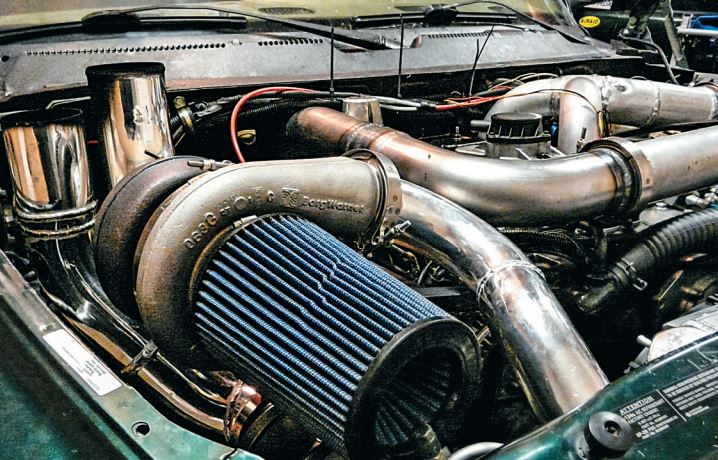Uncategorized
Turbo School Part 1
The following article was written by Power Driven Diesel Co-owner Todd Welch and originally appeared in the August 2016 issue of Diesel Tech Magazine.
When I first got into diesel performance years ago, I didn’t have the knowledge I needed to make educated decisions. That didn’t stop me from buying parts, though, and I ended up purchasing a lot of parts that did not fit my goals. I did learn a lot from those mistakes and that led me down the road of knowledge acquisition. My goal in these articles is to help you get a solid knowledge base that will protect you from buying parts that don’t fit your goals. Also I am hoping that after these articles you will know what questions to ask companies you deal with, and if the answers you get back are based on fact or opinion.
With that, let’s start with turbos. I have loved turbos for as long as I can remember and have studied them extensively. One Christmas all I got from my wife were turbo textbooks! What we need as consumers is knowledge on how to decide which ones will work for our intended application. For that we need to understand the math involved in sizing them. In the following articles we are going to size turbos based on math, predict the power we will make, and then test them on the dyno to verify. We will be testing many turbos over the course of the next year.
To test all these turbos we will be using an older 12-valve Cummins so all of the math will be based on that engine. The equations will work on all engines; you just need to plug in the numbers for your particular engine. First thing we need to decide is how much power we want to make. For this project let’s shoot for 500hp at 2500 RPM with a single turbo. Further, I want 500hp to the ground, not at the crank, which is an important distinction when picking turbos, because manufacturers establish power ratings at the crank, not the wheels.

The flow capabilities of turbos are rated in pounds of air moved per minute, usually shown as (lb/min). From past experience I have found that in a truck tuned for street use I can expect between seven to eight horsepower to the ground for every pound of air moved. Seven horsepower per pound of air is probably a little low, but I usually do the math based on seven horsepower to ensure I have enough air to meet my goals.
Go Figure
That leads us to our first equation on how to figure out air requirements: (500hp X 1 lb/min)/7hp or simply 500/7. The answer to that is our required airflow which means we need to flow 71.42 lb/min through our system. It should be noted that these equations are for real, uncorrected horsepower to the ground. There will be many who have made more than 500hp on a dyno with 71 lb/min but those numbers are usually corrected which means that they add a percentage to the actual number to simulate what the vehicle would make under ideal conditions. I really only care about making the power I want in the conditions I am in and that usually ends up between 7-8hp to the ground uncorrected.

Now that we know our airflow needs we need to calculate how to get that airflow through our engine. At this point we need some numbers to plug into our calculations. Here is the info based on the 12-valve Cummins engine we will be using for testing:
• 359 cubic inches
• 2500 rpm
• 85% = Volumetric efficiency
• 7 horsepower per lb/min
• 71.42 lb/min required
Let’s start with 359 cubic inches. This diesel engine is a four-stroke, which means it takes in air every other revolution. To get the airflow, we need to divide our engine size by two, which yields 179.5 cubic inches of airflow every time the engine spins one revolution. We are designing this for 2500 RPM, so we multiply our engine size by RPM which gives 448,750 cubic inches per minute of airflow. That is a rather useless number since everything is measured in cubic feet per minute, so divide that by 1728 to convert it to CFM. After that calculation we are left with 259.69 CFM. This is what our engine would flow if it was 100 percent efficient. Since it is not, we must multiply the CFM by its volumetric efficiency (VE). Taking 285.66 times 85 percent gives us a whopping 242.81 CFM to work with. To put in perspective how terrible that is for power production here is another conversion for you. To convert CFM into lb/min you simply multiply your CFM by .069. 242.81 X .069 = 16.75 lb/min. That is a long way off from our desired 71.42 lb/min that we need to make our power.

The great thing with turbocharging is that we will be able to get the air we want through that poor flowing engine! Keep this issue handy because you we are going to start off the next article right where we left off here and you will want to refer back to this article as we get deeper into the math next month.
If you have questions on how to get the best setup for your truck to produce the best dyno numbers, contact us or call us at 435.962.9555. We’re happy to help you get the best parts for your truck, many of which can be found in our online store.

